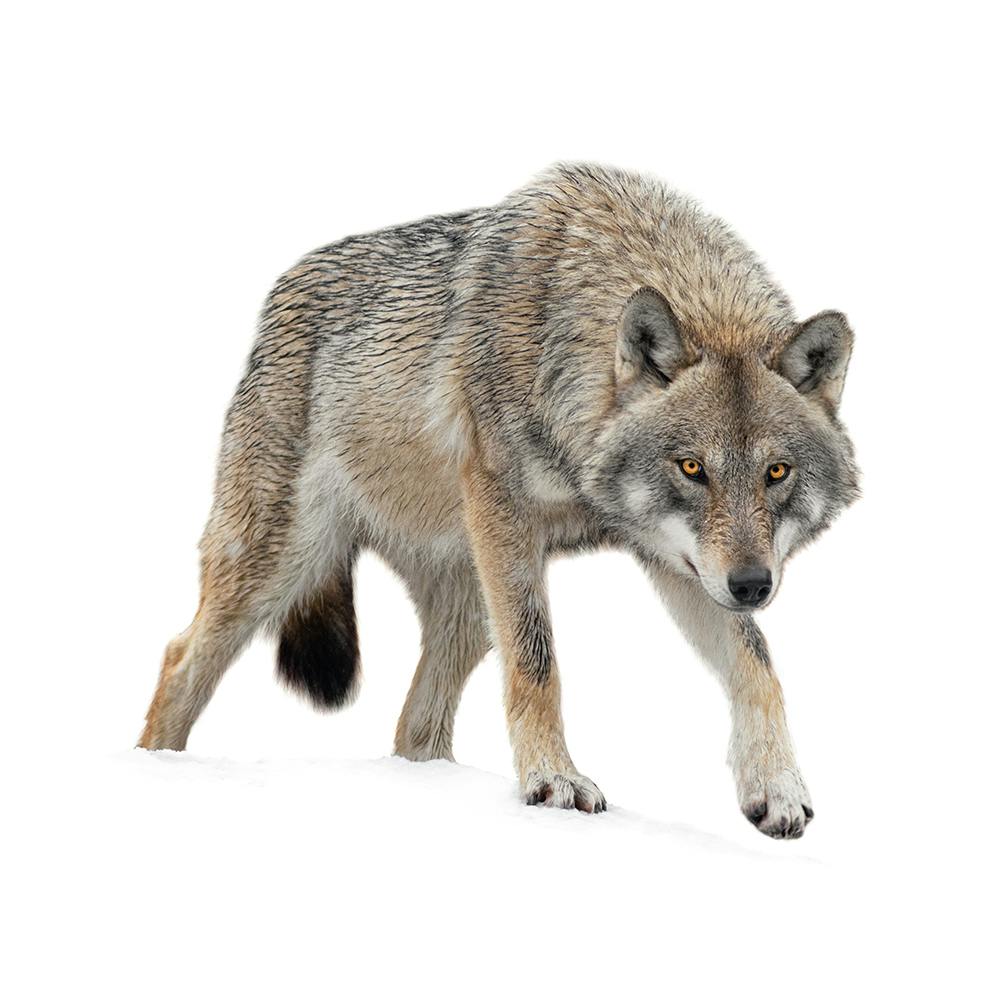
Wolf
The gray wolf (Canis lupus), also known as the timber wolf, western wolf, or simply wolf, is a wild canine native to Eurasia and North America. It is the largest extant member of the Canidae family. Wolves are ancient animals. Fossil records indicate that they split from other members of the Canidae family around 1 to 2 million years ago. Humans and wolves have a long history together, evidenced by early cave paintings and burial sites. In fact, DNA evidence suggests that dogs, which are descendants of wolves, were domesticated somewhere between 20,000 to 40,000 years ago.
- Origin
- North America, Eurasia
- Alternate Names
- Wolves are not classified in the same way as domestic dog breeds, but by species, subspecies within the genus Canis. Some subspecies of Canis lupus include Arctic wolf (C. l. arctos), the Eurasian wolf (C. l. lupus), and the Mexican wolf (C. l. baileyi)
- Life Expectancy
- "In the wild, wolves typically live 6 to 8 years, though some have been known to live up to 13 years. In captivity, where threats such as starvation and conflict with other wolves or humans are minimized, wolves can live up to 15 to 20 years. "
- Average Male Height
- Depends on sub-species. Typically 27-33 inches
- Average Female Height
- Depends on sub-species. Typically 27-33 inches
- Average Male Weight
- Depends on sub-species. Typically 60-120 pounds
- Average Female Weight
- Depends on sub-species. Typically 60-120 pounds
- Coat Length
- MediumLong
- Coat Type
- Their fur tends to be shorter on the face and limbs, and longer on the body and tail.
- Coat Colors
- "Variety of colors. However, many wolves' coat colors range from pure white to brown, grey, cinnamon, and black. According to Western Wildlife Outreach, and organization that educates about large carnivores in the U.S., the subarctic and boreal forest regions black and gray are common, while in the arctic, white and light-colored waives predominate. In the South, Gray phases prevail. The wolves in northwestern Montana are predominantly gray or black."
- Coat Pattern
- Markings and/or Mask in variety of colors.
Genetic Predispositions and Health
As with many wild animals, wolves have evolved to be relatively hardy in terms of genetic health. However, population fragmentation and loss of genetic diversity due to human activities (like hunting and habitat loss) can lead to inbreeding, which may increase the prevalence of genetic diseases. Wolves are known to occasionally suffer from diseases such as mange, heartworm, and parvovirus
Personality and Behavior
Wolves are social animals, living and hunting in packs that are typically made up of family members. They are highly territorial, using scent marking, howling, and direct confrontation to protect their territories. Wolves communicate using a complex system of vocalizations, body postures, and scents.
Despite their reputation in folklore and popular culture, wolves are generally wary of humans and not aggressive toward them unless provoked. They are intelligent, adaptable animals capable of surviving in a variety of habitats, from arctic tundra to desert regions.
Fun Facts
Wolves are excellent hunters, and their diet primarily consists of large ungulates, like deer and elk, but they can also consume smaller prey or even survive on scavenged meals when necessary.
Wolves have a very expressive behavior, and they use their tail position, ear position, facial expressions, body posture, and vocalizations to communicate with each other.
A wolf's howl can be heard up to 10 miles away in open terrain.
Wolves have a significant role in their ecosystems. By controlling prey populations, they can indirectly benefit many other plant and animal species.
References
https://westernwildlife.org/gray-wolf-canis-lupus/library-2/
Mech, L. David; Boitani, Luigi (2003). "Wolves: Behavior, Ecology, and Conservation". University of Chicago Press. ISBN 978-0-226-51698-1.
Mech, L. David (2004). "The Wolf: The Ecology and Behavior of an Endangered Species". University of Minnesota Press. ISBN 0-8166-1026-6.
Young, Stanley P.; Goldman, Edward A. (1944). "The Wolves of North America". Washington, D.C.: American Wildlife Institute.
Thalmann, O.; Shapiro, B.; Cui, P.; Schuenemann, V. J.; Sawyer, S. K.; Greenfield, D. L.; Germonpré, M. B.; Sablin, M. V.; López-Giráldez, F.; Domingo-Roura, X.; Napierala, H.; Uerpmann, H.-P.; Loponte, D. M.; Acosta, A. A.; Giemsch, L.; Schmitz, R.; Worthington, B.; Buikstra, J. E.; Druzhkova, A.; Graphodatsky, A. S.; Ovodov, N. D.; Wahlberg, N.; Freedman, A. H.; Schweizer, R. M.; Koepfli, K.- P.; Leonard, J. A.; Meyer, M.; Krause, J.; Pääbo, S.; Green, R. E.; Wayne, R. K. (2013). "Complete Mitochondrial Genomes of Ancient Canids Suggest a European Origin of Domestic Dogs". Science. 342 (6160): 871–874. doi:10.1126/science.1243650. PMID 24233726.
"The Wolf as a Carnivore". International Wolf Center. Retrieved 24 February 2019.